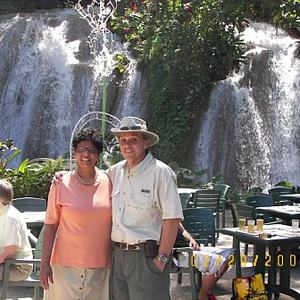This motion sickness medication has a scary reputation.
For many, this prescription medication is the sure-fire way to avoid vomiting on a cruise. Yet in other forms, “The Devil’s Breath” can also be one of the most feared drugs in the world.
Eager North Sea TikTok enthusiasts all wanted to know what it was like to cross the Drake Passage on the way to Antarctica. At its worst, the infamous passage launches ships over 50-foot waves, tossing everything inside asunder. I had no such tales. Over and over, I summed up the Drake Passage in one sensory fever dream: “I was high on my anti-nausea patch for a day and a half, and people kept checking on me because I was feeling the wallpaper.”
Scopolamine, as a prescribed transdermal patch that relaxes the central nervous system, undoubtedly kept me from the pervasive nausea that otherwise accompanies my maritime adventures. It didn’t give me the Dramamine knock-out, but a floaty, de-realized sensation with a delicious tactile hyper-focus. Clapping my hands gently on the hot tub water or stroking the ship’s woven leather walls was a trip within a trip.
Yet scopolamine takes a dangerous turn in powder and tablet form. Called Devil’s Breath, or burundanga, this powerful narcotic can incapacitate and even kill its victims. From medieval witchcraft myths to truth serum to modern jewel thieves in Paris and kidnappers in Colombia, scopolamine can’t shake its sinister reputation, and current travel warnings still have this drug right in the scary spotlight.
Recommended Fodor’s Video
Why Scopolamine Safely Works for Travelers
Scopolamine can be a game changer for those who suffer on the seas. Naturally occurring in nightshade plants like mandrakes and belladonna, it inhibits the body’s parasympathetic nervous system’s cues, the “rest and digest” functions, relaxing the muscles in your stomach and bowels. This prescription patch is a small disc that sticks behind the ear and comes in clutch for many when other remedies fail. As with any prescription, always consult your doctor before use. Most travelers get the green light to keep it on for up to three days for motion sickness, which is convenient dosing for cruisers who are losing track of time.

But while scopolamine even slays nausea after surgery, it’s not perfect. The most common side effects include dry mouth, drowsiness, pupil dilation, and restlessness. But for some of us, things get a little…loopy.
“I was high on my anti-nausea patch for a day and a half, and people kept checking on me because I was feeling the wallpaper.”
After six hours of sticky goodness, I started to feel that shift in perceptual awareness. My feet weren’t connecting with the ground at their normal speed as I trailed my finger along the wall like a toddler. I was sailing on a Viking expedition ship, a masterpiece of tactile design. I have no idea how much time I spent caressing the stitching on fuzzy flannel, picking at woven leather, tracing the edges of cutouts, and playing mental hopscotch on tiles by the spa. I’m prone to flights of fancy, so it took a friend’s amused check-in to clue me in that I was high.
A more clinical explanation: I am one of the travelers who experiences the less common mild psychoactive properties of scopolamine’s ability to pass through the blood-brain barrier. I could still function in my blissful float, the envy of a few unaffected patch pals. But as soon as we got to calm coves, I peeled off my micro-dose of unintentional mind alteration. The patch’s small dosage and rate-controlling membrane keep this safe, if a bit strange. Yet, in other forms, scopolamine has become the bane of travelers worldwide.
The Dreaded Devil’s Breath
Scopolamine, or hyoscine, has a dramatic history of healing, harm, and hallucination. For centuries, civilizations worldwide have used nightshade plants for medicine and mind-bending rituals. Some suggest it was part of a potion used by witches for a flying sensation. By the beginning of the 20th century, doctors were using scopolamine as early anesthesia and to bring on “twilight sleep” for mothers in labor.
As these sedated women spoke without inhibition, the medical world believed this might be an elusive truth serum that would change criminal justice and espionage. For the first half of the 1900s, scopolamine was a dreaded go-to for law enforcement and militaries despite questionable results. Ultimately, scopolamine fell from favor. The side effects were too much to overcome, especially hallucinations.
Even modern scopolamine can’t shake its reputation of mind control. Enter Devil’s Breath, the drug’s infamous form. High doses hit the central nervous system too hard, knocking people unconscious for 24 or more hours and potentially causing lethal respiratory failure. The lore builds with “the million dollar ride,” with reports of people who weren’t unconscious but amnesic, losing hours from their memory and discovering they submissively withdrew massive funds from their banks for thieves.
Tales explode from there. In 2015, scopolamine reportedly enabled a Paris gang to drug people on the street, “turn them into zombies,” and rob their homes. The wicked twist: perpetrators reportedly blew the powder into victims’ faces.
Kidnappings, primarily through Ecuador, Colombia, Peru, and Chile, have been reported for decades with scopolamine as the culprit. From spiked drinks to laced cigarettes, the modus operandi is inventive and sinister. An insidious hostel urban legend survives where backpackers accept business cards, flyers, coupons, and handouts from strangers that are laced with the drug, creating zombies with just a touch.
How to Stay Safe out There
While Devil’s Breath, for decades dubbed “the most dangerous drug in the world,” may be a catch-all for all chemical crimes. Yet there is no denying that the threat is real. The U.S. Embassy in Colombia warns travelers of an increase over the last year in criminals using sedatives–especially scopolamine–to drug and rob victims. Slipping liquid, powder, and spray scopolamine drug food and drinks in clubs is still a risk, but dating apps are the new tool, luring targets into socially disarming meets. It’s a terrifying experience, and people can lose days of consciousness, sometimes without hospitalization.
From Colombia to Canada to Cambodia, the Embassy’s advice is sound. Watch your drinks. Don’t go to clubs by yourself and leave with strangers. If you plan to meet a match from an app, tell someone beforehand where you’re going, who you are meeting, and their account details. Victims are robbed of their electronics, waking up in unfamiliar surroundings with no way to reach out, making and getting help and providing evidence more complicated abroad.
Scopolamine also has a less-known place in club scenes. Recreational drug users find the relaxed vibe giving way to frightening visions, aggression, and memory loss. High doses lead to loss of consciousness and even fatality. Don’t dabble in this addictive drug, and decline substances from strangers.
Stick to scopolamine patches as prescribed, grab a favorite fabric to fondle just in case you get that soft buzz, and enjoy not spending most of your time at sea fighting a losing battle with your guts.
Sorry about the hard time you had with this. At one point, you referred to this as narcotic and it's not. It's classified as an anticholinergic. actually adverse reactions like this or like the one you had are rare. But yes, they can happen. You know this is not the anti-emetic for you. The FDA would not have this drug on the market if such reactions like you had were more common place.this drug has been used safely for decades. When use as prescribed it's effective. However when abused it's dangerous.







My wife gets very seasick....butt no more. She tried pills.... patches... but too much for her.... she got SEA BANDS at our pharmacy. WORKS WONDERS with pressure points... not putting anything into your body.1.